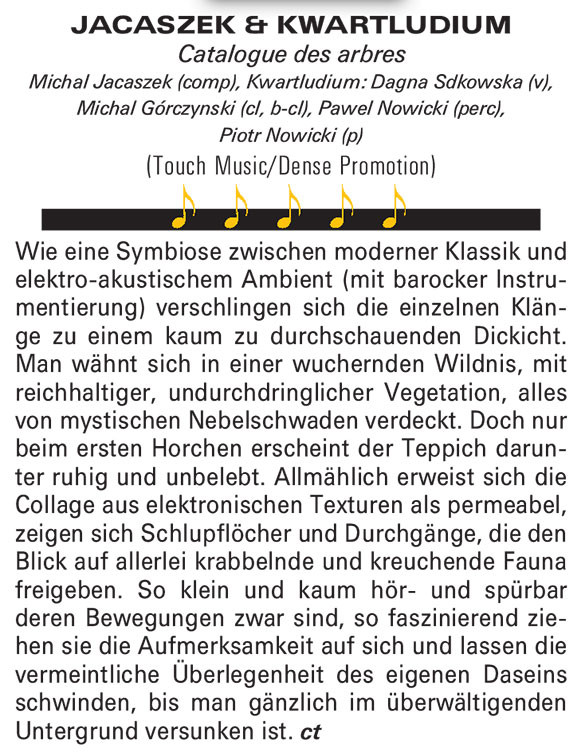CD – 8 tracks – 46:06
Track listing:
1. Sigh (Les peupliers)
2. Green hour
3. A book of lake (Roselière)
4. Garden (Les sureaux)
5. From a seashell
6. Circling (Le pré)
7. Anthem (La forêt)
8. Kingdom (Les chênes, les bouleaux)
For the past decade or so, Polish musician Michal Jacaszek has been exploring a new, resolutely modern chapter in Eastern Europe’s long, storied love affair with classical music. His creations are painstakingly crafted collages of electronic textures and baroque instrumentation, harpsichords being swarmed by woolly static one minute and pulled apart by billowing wind the next. A push-and-pull tension runs deep and constant throughout. Ambient music is rarely so sonically challenging. Jacaszek has recorded for Ghostly International, Miasmah, Gusstaff Records and Experimedia and other labels. This is his first release for Touch.
Michał Jacaszek writes:
“When poets and writers declare their enchantment for the forms of nature, they often use musical terms as metaphors. Visual artists’ creations often resemble graphic partitas, when recapturing the rhythms of landscapes. Confirming, in a way, these musical intuitions, composers write great music deeply inspired by birdsongs, wind rustlings, waves repetitions etc.
Making “Cataloguge des Arbres”, my ambition was to join this broad artistic movement devoted to natural phenomena and find my own way to describe trees: their forms, atmosphere and mystery. I have started with “open air” recordings, capturing mainly leaves” rustlings – from different distances, in different locations and weather conditions. This collection of nature recordings was transformed into a kind of “organic drone” and becomes a main background for instrumental and voice improvisations. My initial inspiration here was Olivier Messiaen’s’ bird songs transcriptions for piano – the composer’s work title “Catalogue d’Oiseaux” I have paraphrased on my album . A piano, clarinets, violin and percussion parts, performed by the Kwartludium ensemble, were electronically processed, and afterwards all this electro-acoustic material was turned into a collection of 8 soundscapes – forgotten songs performed secretly by my beloved trees.”
composed, recorded and produced by Michał Jacaszek | additional composing and all instrumental parts performed by Kwartludium | Voice parts (tracks 1, 8) performed by 441 Hz chamber choir | Additional clarinet parts (tracks 2, 3) performed by Andrzej
Wojciechowski Grand piano recorded by Cezary Joczyn at Gdańsk Academy of Music
Kwartludium are Dagna Sadkowska: violin | Michał Górczyński: clarinet, bass clarinet | Paweł Nowicki: percussion | Piotr Nowicki: grand piano
Biography:
Michał Jacaszek lives in Gdansk, Poland.
Author and producer of electroacoustic music, composer of soundtracks and theatre music, and sound artist. He is a curator of C3 Festival /Club Contemporary Classical/. Member of Polish Society for Electro-acoustic Music. Michał Jacaszek lives in Gdansk, Poland. Jacaszek gained Grand Prix at “Dwa Teatry” Festival for music composed for the play “Golgota Wrocławska” directed by Jan Komasa. “Walking underwater” a documentary by E. Kubarska with music by Jacaszek has recently been awarded The Special Jury Prize at Hot Docs Film Festival in Toronto.
He has performed in USA (Unsound New York, Communikey, Hopscotch), in Canada (Mutek ), in Great Britain (Fertilizer Festival, Apha Ville Festival), in Nederlands (Urbanexplorer Festival), in Belgium (Fereejen Festival), Portugal, Sweden (Volt Festival), Slovakia, Germany, Ukraine and Russia (Electro-Mechanica Festival); as well as in Poland at the most important festivals: Heineken Opener Festival, Off Festival, Unsound Festival, Astigmatic.
www.jacaszek.com
www.kwartludium.com
Reviews:
You can read an interview here and a review in Polyphonia by here by Łukasz Komia, both in Polish Incendiary (UK):
Sometimes listening to things that sound like everything and nothing is just the best. This record purports to evoke the sounds and feel of the forest; and in doing so uses a whole host of classical and modern techniques. In keeping with a lot of modern classical there is a direct link with the past masters, and here the link to Messiaen’s Catalogue d’Oiseaux can’t be a coincidence. In many ways Catalogue des Arbres has a feel of a work of the late 19th century. In its approach it’s reminiscent of Debussy’s La Mer, the naïve jungle images of Henri Rousseau, or the weird phantasmagorical images of Odlion Redon. It’s also drawing heavily on a deep seated, very Polish love of the forest; especially the Polish relationship with the primeval tracts of forest such as Białowieża, one that has shaped that country’s worldview since the year dot.
But it’s also a great listen on a lot of very accessible levels; at turns incredibly quiet and restful in other passages very, very theatrical and grand, and a record that touches on a whole host of musical conceits to make its point. Despite it being deserving of reams of text as to its making, (as there is a great deal of background and intellectual hinterlands that were explored in this LP’s recording) you can just enjoy the utter sensuousness of Catalogue des Arbres. A Book of Lake or Circling both have a jazzy, post-rock feel that could sit very comfortably on a Miles Davies record. The cracking, sparky and hypnotic Kingdom is really close to Conny Schnitzler’s Divine musings. There’s also a fair bit of the bright, pinpoint aestheticism of the Radiophonic Workshop in here, or the sleaziness of Studio G, for that matter. If we are talking about feel as being the driving motif, then we should mention the buildup on Green Hour, which is marvellous; a slowly creeping piano coda creates a structure for a wider range of crackling and fizzing noises, which are balanced against clarinet and violin. Elsewhere, From a Seashell threatens to explain itself throughout but never does so; preferring to build up an increasingly suffocating aura of suspense. The brilliant chinks of the triangle are wonderful counterpoints to the creepy backlight.
So a great, disturbing, enervating listen, don’t feel intimidated; and in the words of the immortal Brian Clough, get in there! [Richard Foster]
Norman Records (UK):
I have some great stuff on this week. Last week was a little underwhelming but a new Touch release is always gonna to have this old pooch wagging his eager tail.
I won’t harp on too much about this guy’s work. I have a huge place in my heart for the astonishing ‘Treny’ and also the ‘Glimmer’ album he delivered for Ghostly was pretty awe-inspiring too. Michał Jacaszek’s material is a passionate fusion of electronic textural manipulation, smoky chamber jazz and abstract classical rushes. Much like fellow visionaries Deaf Center, this talented Pole fuses his worlds into magical ambient soundscapes that are as engrossing and otherworldly as you could care for.
Unfortunately I cannot quite make out who the significant other featured here, Kwartludium, actually is. I have discovered though that the effortless glory of rustling tress and the majestic weather-beaten landscape make up the main body of inspiration here. He’s been out in all conditions apparently gathering sonic detritus with which to embellish his occasionally unsettling experiments in lushness. This is like a musical interpretation of a Tarkovsky film. Lots of rustling and watery effects. You have no idea what’s gonna come at you next from out the shadows! Once again I find myself drifting off to perfectly poised and almost cinematic music with wonderful jazzy flourishes, organic ephemera and a tender layer of processed field recordings. A lovely way to spend a Friday lunchtime!
Graceful, windswept, mysterious and gorgeously rendered, this is another sublime entry into the eventual fine legacy of Mr. Jacaszek. [Brian]
pop music (Poland):
Sakralny charakter swojej muzyki, Michał Jacaszek prezentuje już od płyty Treny. O ile tamten album pozwolił wypłynąć mu i sprawił, że rozpoznawalność jego nazwiska się zwiększyła, o tyle na tle jego późniejszych albumów wydaje się stosunkowo najłatwiejszym i najbardziej przystępnym materiałem. „Pentral” zaowocował w analizę akustyki wnętrz kościelnych, próbę połączenia możliwości nagrań terenowych i wybrzmiewających w gotyckich budowlach instrumentów oraz wokaliz. „Catalogue des Arbres” ten kierunek pogłębia – to rozbudowana i wieloetapowa współpraca z trójmiejskim zespołem Kwartludium, poruszającym się na co dzień po obszarze muzyki współczesnej. Jacaszek wykorzystuje ich cytaty, edytuje nawiązania do Catalogue de Oisseaux Oliviera Messiaena, przetwarza, aby potem nałożyć kolejne ścieżki improwizacji kwartetu, który oszczędnie sączy brzmienia klarnetu, fortepianiu, perkusjonaliów, marimby czy wiolonczeli. Wspólny obraz budują z nim równolegle nagrania terenowe natury, tytułowy szum drzew, daleki od oryginału, funkcjonujący jednocześnie jako tło i baza drugoplanowej ścieżki dźwiękowej. To subtelny dron, kontrapunktowany przez dźwięki instrumentów.
Album wydany przez Touch to muzyka ciszy, tak jak pozamiejski krajobraz – interwencje w audiosferę są ledwo słyszalne, delikatne, rzadko kiedy dźwięki przyjmują formy złożone. To proste elementy, które razem budują barwny, dźwiękowy kolaż. Zajmujący się ekologią akustyczną R Murray Shaffer wyróżnił audiosferę miast i obszarów wiejskich, kategoryzując ją na lo-fi – średniej jakości hałas miejski – i hi-fi – złożony, o wiele łatwiejszy do rozłożenia na czynnki pierwsze, obraz dźwiękowy wsi i krajobrazów naturalnych. Catalogue des Arbres odwołują się do tej drugiej kategorii – wielowarstwowość i nacisk na detale to jedna z największych zalet tego materiału. Drugą jest ich oszczędność, skrupulatne ułożenie i improwizacja Kwartludium, która w ten pocięty materiał wprowadza pierwiastek ludzki. Catalogue des Arbres wydaje się najdojrzalszym albumem Jacaszka – jest najmniej oczywisty, nie tak dramatyczny i prosty jak Treny, z wyraźnie wyklarowaną wizją muzyki i wykorzystaniem nagrań terenowych. Nie jest to płyta łatwa, trzeba się w nią wsłuchać, także na dobrej jakości sprzęcie. Muzyczny katalog jest bogaty w dźwięki, odwołując się w naturalny sposób do cyklu i formy dźwięków, słyszalnych w naturze. Błyskotliwie i szalenie inteligentnie zrealizowany materiał. [Jakub Knera]
The Wire (UK):
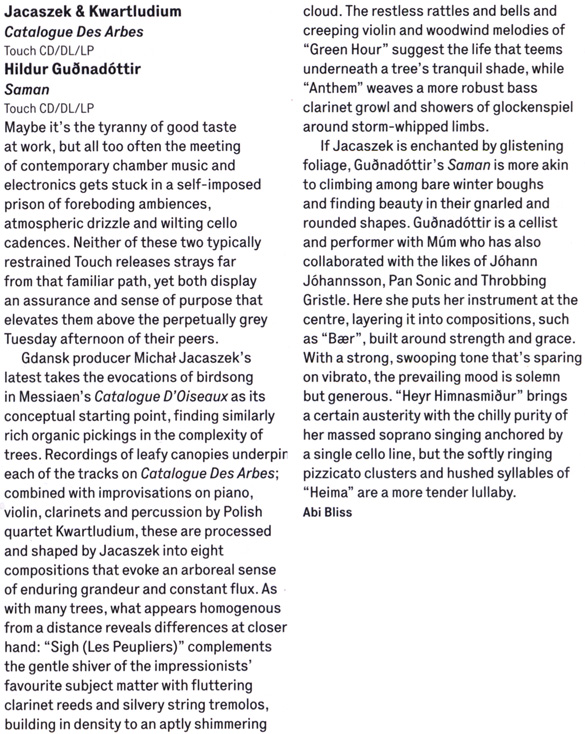
hhv (Germany):
Für seinen »Catalogue d’Oiseaux« sammelte der Komponist Olivier Messiaen auf seinen Reisen rund um die Welt einst Tonaufnahmen von Vogelstimmen, die er anschließend in Noten transkribierte, um daraus einen Klavierzyklus zu machen. Auf ein solches Verfahren konnte der polnische Musiker Michał Jacaszek für seinen von Messiaen inspirierten »Catalogue des Arbres« nicht zurückgreifen, die Musik der Bäume eignet sich dann doch nur eingeschränkt zur Übersetzung in Töne. Stattdessen verwendete er einfach Field Recordings von raschelnden Blättern in seinen Stücken, verfremdete die Geräusche manchmal digital zu Drones und kombinierte sie mit herkömmlichen Instrumenten wie Violine, Klavier und Klarinette, die zum Teil ebenfalls am Computer bearbeitet wurden. Jacaszeks elektroakustische Musik hält die beiden Ebenen so weit auseinander, dass Instrumente und Naturgeräusche überwiegend als verschiedene Quellen erkennbar bleiben, fügt sie zugleich aber so behutsam ineinander, dass sie nicht nur höchst friedlich koexistieren, sondern sich wie von selbst zu ergänzen scheinen. Bei der Gestaltung der Kompositionen mag die scheinbar statische Natur der Bäume Pate gestanden haben, hier fließen die Klänge in unbeirrbarer Ruhe, sodass leicht dunkel eingefärbte Passagen schon zu dramatischen Höhepunkten geraten können. Am Ende bleiben von den Bäumen die Gelassenheit und ihr »Mysterium«. [Tim Caspar Boehme]
kindazmuzik (Netherlands):
Liedjes van de bomen; het klinkt wat knullig wellicht maar dat is wat de Pool Michael Jacaszek op Catalogue des Arbres zegt te presenteren, met medewerking van het ensemble Kwartludium. Deels is dat letterlijk te nemen, want de componist maakt veelvuldig gebruik van natuuropnamen. Een nog veel groter part van zijn werk wordt ingenomen door op de natuur geënte, gecomponeerde muziek. Op dit album gaan die twee samen om zo niet zozeer een ode aan de boom te brengen, maar om je ernaar te laten luisteren.
Wanneer dichters of schrijvers verrukt zijn van de natuur, gebruiken ze nogal eens muzikale metaforen. Ook beeldend kunstenaars vangen landschappen in vormen die lijken op grafische partituren. Componisten op hun beurt – en zeker Jacaszek – schrijven fantastische muziek met vogelgezang, wind, geritsel van bladeren en herhalende golfslag als inspiratie. Jacaszek voegt daar zijn loot aan toe door bomen onderwerp van zijn composities te maken.
Als basis dienen natuuropnamen in de open lucht. Hij pikte geritsel en geruis op, op verschillende afstanden, met diverse weersomstandigheden. Daarvan maakte hij thuis in de studio een organische drone als fundament en achtergrond. Daarop en daarvoor liet Jacaszek alle ruimte voor instrumentale en vocale improvisatie. De natuur neemt dus nooit de voorgrond, zoals bijvoorbeeld bij Chris Watson.
Partijen gespeeld door piano, klarinetten, viool en percussie werden door Jacaszek elektronisch bewerkt. Samen met het natuurgeluid gaan ze op in acht soundscapes. Die zijn schatplichtig aan Messiaens Catalogue d’Oisseaux al probeert Jacaszek geen transcriptie voor instrument te maken van natuurlijke geluiden. De originele klankenrijkdom krijgt op een briljant organische manier gezelschap van de instrumentatie en andersom. Zo inspireren de bomen hun eigen gezang via Jacaszek. De kans is groot dat je bij een volgende park- of boswandeling zijn vloeiende instrumentatie al vanzelf denkt te horen bij het ruisen van de wind door de taken. [Sven Schlijper]
VITAL (Netherlands):
From the outside it may seem that Touch always works with the same artists and to some extent that’s probably true. What’s wrong with that? They act as a proper record label, not working on a project-to-project basis, but push a limited number of artists. But sometimes an entirely new name pops up, such as Michal Jacaszek from Poland, who is a composer of soundtracks and theatre music, as well as a curator for various festivals. His previous work was released by Ghostly International Miasmah, Gustaff Records and Experimedia, although I must say I didn’t hear any of that. Here he works with a quartet called Kwartludium: Dagna Sadkowska on violin, Michal Gorczynski on clarinet and bass clarinet, Pawel Nowicki on percussion and Piotr Nowicki on grand piano. Much like composers have tried to describe animals through instruments (Messiaen, Saint-Saens), Jacaszek wanted to describe trees, ‘their forms, atmosphere and mystery’. He started with the recording of leaves rustling and wrote the notes out for the quartet and then, in the final stage, treated everything in a way that is owed to the world of electro-acoustic music. The 441 Hz Chmaber Choir performed some voice parts. Great story, fine music, which carefully balances on the modern classical on one side and electro-acoustic music on the other side. Jacaszek really makes his sounds – whatever source – to have a rustling character, such as in ‘Garden (Les Sureaux)’ – which rustles all around – the field recordings, the percussion instruments, but also the other instruments making similar gestures. Most of the time this is played introspectively, but not dark, doomy. It’s airy music, open, like a mild summer breeze (and with today’s sunny weather I can exactly know how that feels), meandering through space, without getting weightless or new age inspired. Jacaszek knows how to create music that is partly gritty, a bit dirty, just off the beaten track. I’m never too fond of anything that is even remotely modern classical, but I must say: this is great! [FdeW]
Fluid Radio (UK):
The dark trunks are as grey as bleached stone. Their dull, shaded leaves perform a slow, almost balletic routine in the pitch-black of the night, absent of white stars. It’s done in private, with only a couple of nocturnal eyes glinting from beyond. Natural rhythms sway in time with their slender arms, a hundred trees participating in an ancient ritual. Their rhythm is true, tried and tested. Their trunks are thick bodies that populate the planet. Instruments are bodies, too. With clarinets, violins and piano performed by the Kwartludium ensemble, the sublime beings house the music before it’s released into the wild.
Trees have been around much longer than we have and are considered sacred the world over, minus the brutal deforestation that we see today, a sad reminder that all is not well. Oaks were once worshiped by European druids, and Redwoods were an integral part of American Indian ritual. They are stony, monolithic, breathing life into the world. And polish musician Michal Jacaszek breathes life into his music. It takes on a new, ashen form. The percussive shaking sounds like a quivering branch; leaves rustle in the dead of night. In the natural, wooded house of leaves, birds nest and nestle, taking refuge. They harbor life and oxygen. A leafy tree in its prime will produce as much oxygen in a season as ten people inhale in a year.
Creaking timbres and dissonant piano notes drip with a grey, murky mystery. Recurring chords cloud the music, and low, ominous bursts of piano rumble like tropical thunder. The strings seep tears of discontent. Jacaszek has chosen to explore the natural beauty of trees – ‘their form, atmosphere and mystery’. Their beauty has been much admired and, as a result, is often taken for granted. Jacaszek concentrates on the darker, twisted roots underneath the surface – something that we don’t normally see – and the well hidden secrets they keep. The music is detailed; close up shavings that scrape against the trunk of the tree. The trees are alive, mixing in with the sound of steady rainfall and the chirp of the birds. Percussion patters down, filling up empty cans with a light, tinny sound. A sung chorus comes out of nowhere, but it’s a leafy language.
Catalogue des Arbres is a tonal forest, a dense jungle rooted with slithering shrubbery and vines that snake their way through the undergrowth. The notes seem to know their way around this place. The clarinet isn’t as bright as it once was, the tone becoming noxious, falling under a dreamy enchantment after a chance meeting with Maleficent. Wooden carvings litter the side of the trunk, signs of cherished teenage love. I <3 u 4eva.
Jacaszek recorded the leaves at various locations, distances and in different weather conditions. This adds a chilling authenticity to the mystery currently developing in the brooding glow of the dark room, where Jacaszek’s photographs find their form. Strange black shapes appear beside the trees, apparitions that hone in on their victim. The trees intend to keep their secrets; you need to be on your guard in Jacaszek’s neck of the woods.
Music won’t save you (Italy):
Si fa sempre più ampia ed articolata la ricerca di Michal Jacaszek di suoni puri e incontaminati, al più filtrati dal solo contesto d’ambiente nel quale risuonano. Se il contesto ispiratore del precedente “Pieśni” erano gli interni di chiese e cattedrali, in “Catalogue des Arbres” l’obiettivo del compositore polacco è ancora più ambizioso: non semplicemente catturare suoni naturali sotto forma di field recordings ma riprodurre, attraverso una strumentazione in ampia misura reale, le stesse melodie che aleggiano in un ampio contesto paesaggistico, nel quale il fruscio delle foglie di un bosco si protende fino a lambire la risacca delle onde del mare.
Per mettere in pratica tale operazione, Jacaszek è stato supportato dal quartetto da camera Kwartludium, formato da accademici connazionali che da oltre un decennio si occupano proprio dell’esecuzione di opere di giovani artisti impegnati in elaborazioni neoclassiche non convenzionali. L’ensemble così composto (violino, fiati, percussioni e pianoforte) delinea fragili linee armoniche, dominate dal pianoforte e percorse da un fragile universo di screziature, correnti di energia statica e irregolarità increspate che per brevi tratti sfociano persino in contenuti apici di rumore.
Eppure, i contorni degli otto brani di “Catalogue des Arbres” si mantengono tenui e sfumati, muovendo da frequenze tanto basse da rasentare, nell’iniziale “Sigh (Les Peupliers)”, un silenzio che poi continua ad aleggiare tra le sparse note pianistiche di “Green Hour” e assume contorni spettrali in “A Book Of Lake (Roseliere)”. Mentre progressive increspature distorte costituiscono il contrappunto dei segnali naturali nei finali di più di un brano, in “Garden (Les Sureaux)” e “From A Seashell” sono i fiati a incorniciare cartoline percorse da brezze salmastre che nel finale tornano a soffiare enigmatiche tra le ombre di una foresta, effigiata dall’inno silente “Anthem (La Foret)”.
Lavoro tanto ambizioso quanto difficile, “Catalogue des Arbres” sposta il romanticismo gotico di Jacaszek e le sue manipolazioni sonore verso un camerismo austero e dotato di una forte matrice concettuale, che nell’occasione è comunque riuscito a trovare un equilibrio tra le placide visioni e le imponenti forze di una natura osservata e interpretata con rispettosa sensibilità.
Spex (Germany):
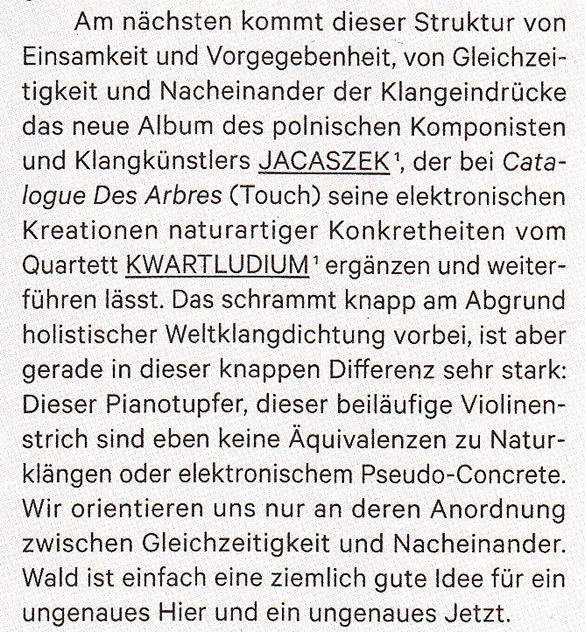
Le Son du Grisli (France):
Les field recordings, certains les proposent tel quel, d’autres les transforment… Michal Jacaszek, lui, les fait accompagner. En l’occurrence par Kwartludium, un quatuor polonais d’allure toute classique (violon, clarinettes, piano et percussions : Piotr Nowicki, Paweł Nowicki, Dagna Sadkowska & Michał Górczyński) mais néanmoins fort inventif.
Son Catalogue des arbres (peupliers, sureaux, chênes…), qui ne manquera pas d’évoquer les oiseaux de Merzbow (à moins que ce ne soit, mais je ne peux pas y croire, ceux de Messiaen), se balance entre deux branches : une atmosphère nébuleuse et un contemporain de nature. Pas étonnant qu’on semble apercevoir, à l’autre bout de la forêt ou caché dans un fourré, Gavin Bryars ou Kronos Quartet, Rafael Toral (première période) ou Mark Hollis (dernière période en date). Sur le souffle de l’enregistrement, les pages du catalogue tournent, délivrant la sève qui y coule et la vie qui y bruisse.
Sonic Seducer (Germany):
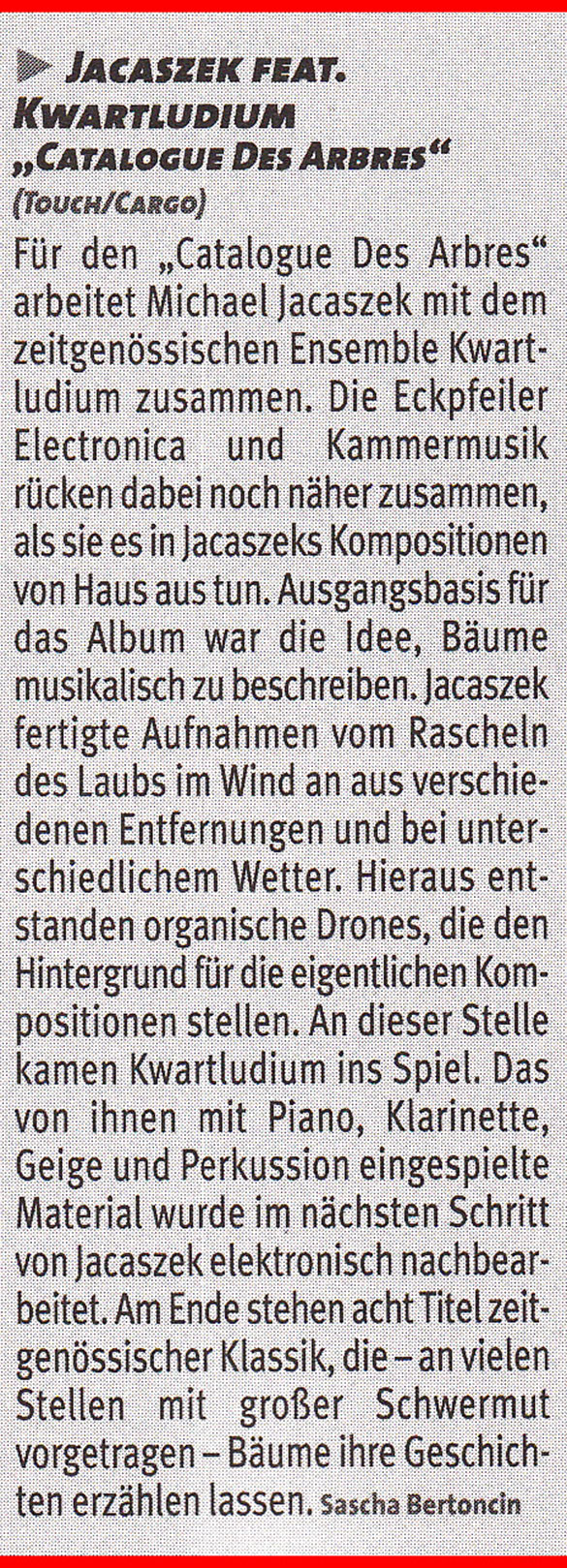
Monsieur Delire (France):
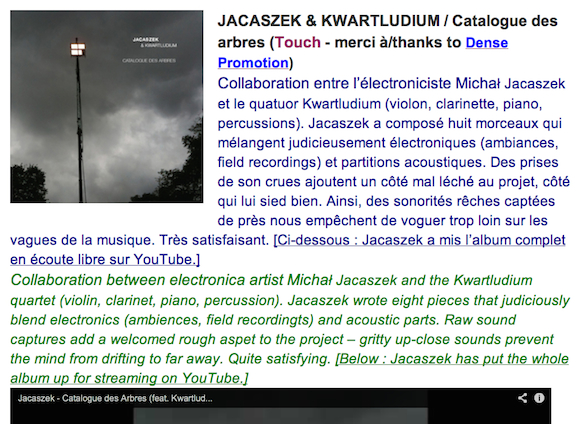
Whisperin’ and Hollerin’ (UK):
The inner sleeve quotes eight lines of early 20th century Polish poet Bolesław Leśmian’s ‘Sonnet’, which tells of ‘a songlike sweetness’ that ‘pours from the forest’, in what could be justifiably described as a Romantic style. It’s in this context that Polish musician Michaɫ Jacaszek, here with the assistance of instrumental ensemble Kwartludium attempts to explore the relationship between artist and nature.
The resulting work is subtle, but that doesn’t mean it’s lacking in atmosphere or interest. Incorporating elements of jazz into a supple, cinematic soundscape of creeping tension and ponderous intangibles. A teetering piano hangs on the precipice above a floating glockenspiel, eddying around dissonant woodwind. Heavy drones build, scraping strings ebb and flow and transition from dark to light. Cymbals like rain wash over a host of incidentals.
Freistil (Austria):
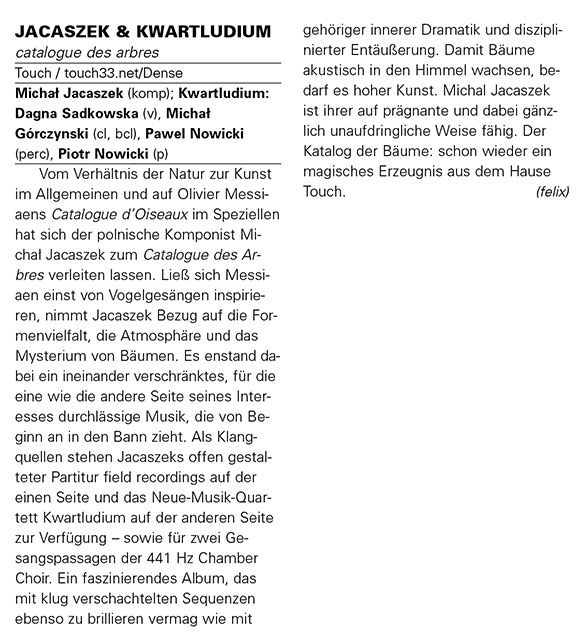
Obskure (Germany):
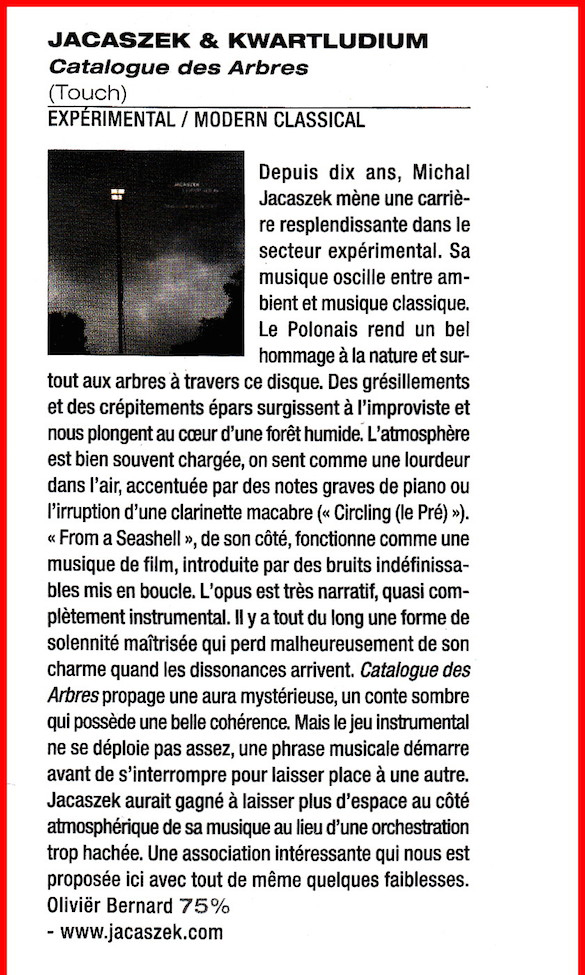
Skug (Austria):
Um einen Katalog der Bäume geht es hier, dabei kann es sich natürlich, da es um Musik geht, nur um eine naturalistische Metapher handeln, die in einem unnaturalistischen Sinn umgesetzt wird. Nicht zuletzt schwebte dem Komponisten Michal Jacaszek der »Catalogue d’ Oiseaux« vor, jene Vogelgesangsvariationen, die so eng verwoben mit dem Werk von Olivier Messiaen sind. Bloß sind, als musikalisches Ausgangsmaterial betrachtet, Vogelgesänge und Bäume doch eher zwei Paar Schuhe. Oder, um einen Satz von Heinz Prüller zu paraphrasieren: »Bäume können nicht singen, sie haben keine Stimmbänder.« Darum eben Kapitel 1, die naturalistische Metapher: Bäume stehen für ehernes Verwurzeltsein, für lebendige Statik, für wogende Weiten. Und Kapitel 2, die unnaturalistische Umsetzung: Jacaszek nahm zuerst Natursounds auf (der Wald, der Wind, das himmlische Kind), wandelte diese Aufnahmen in organische drones bzw. elektroakustische Grundstrukturen bzw. Patterns um, um die herum mit einer klassischen Instrumentierung (Klavier, Violine, Klarinette, Schlagzeug) ein sphärischer Teppich gewebt wurde, teilweise ergänzt um einen Kammerchor und eine Klarinette. Das Resultat: kammerkonzertalische Ambientmusik mit einem Hauch Elektroakustik und dem gewissen naturmystischen Extra. [Curt Cuisine]
Sound of Music (Sweden):
Inspelade ljud från trädens prasslande löv ligger som organisk grund över vilken Jacaszek lägger elektronik samt vokala och instrumentella improvisationer. [Läs]
Headphone Commute (USA):
Touch had a very productive summer in 2014. The focus of this recommendation is an album by Jacaszek & Kwartludium, titled Catalogue des Arbres. The former has been a favorite of mine since the discovery in 2008 by Erik K Skodvin for his Miasmah label, and the introduction of Treny into the world, courtesy of Gusstaff Records. Even though it was Jacaszek’s third proper studio album, it was my very first acquaintance, and that superb modern classical release is still a cherished piece in my collection. With his 2011 Glimmer, Jacaszek managed to appear on Ghostly International label, and now, it is a true marvel to see him among the Touch family of dearest artists.
For Catalogue des Arbres, Michał Jacaszek engages Kwartludium ensemble, to perform all of the instrumental compositions, which he further processes with barely recognizable elements and minimal effects, to turn these eight electro-acoustic soundscapes into “forgotten songs performed secretly by my beloved trees“. Kwartludium, a Polish contemporary music ensemble, comprised of Dagna Sadkowska on violin, Michał Górczyński on clarinet, Paweł Nowicki on percussion, and Piotr Nowicki on the piano, last appeared on my radar when they collaborated with Scanner (the very same Robin Rimbaud) on Graphic Scores for DUX in 2013.
Although most of Jacaszek’s past output usually swirls around the murky vapor of nostalgia, the condition of Catalogue des Arbres slowly slides into a darker, more abstract and dingier space. Based on the field recordings of natural phenomena, the artist aims to create an artistic document capturing this nature through an acoustic lens, if you will, from various locations, distances and weather conditions. Further inspiration comes from Olivier Messiaen‘s bird song transcriptions for piano, similarly titled Catalogue d’Oiseaux, composed in 1958 as a tone poem evoking the landscape, its colors and atmosphere.
“When poets and writers declare their enchantment for the forms of nature, they often use musical terms as metaphors. Visual artists’ creations often resemble graphic partitas, when recapturing the rhythms of landscapes. Making “Cataloguge des Arbres”, my ambition was to join this broad artistic movement devoted to natural phenomena and find my own way to describe trees: their forms, atmosphere and mystery.”
The soundscapes breathe with water, wind, and whispering timbers, punctuated by scattered piano chords, brooding bass clarinet and wondering violins. The resulting sound is sparse, drony, smokey and often dim. Like a soundtrack to a diffused and sharp contrasted film noir, Catalogue des Arbres lingers in the foreground with its lo-fi organic twilight, until it gently dissipates and melts away. The album’s artwork, once again, photographed and composed by Jon Wozencroft, conveys a sense of an early quiet hour on a dark and stormy day. A time and place that trees, I’m sure, don’t mind. Highly recommended. [HC]
Chain D.L.K. (USA):
The integration of instrumental and ambient music with field recordings and sound of nature has almost become a cliche so that the discriminating factor is the aesthaetic quality of such an integration and the aesthaetics that Polish electroacoustic musician Michal Jacascek and the ensemble Kwartludium (Dagna Sadkowska on violin, clarinet player Michal Gorczynski, Pawel Nowicki on percussions and pianist Piotr Nowicki) convey on this “Catalogue des Arbres” (French for “Catalogue of Trees”) is undoubtedly sterling from this point of view. The choice of a French title is not a matter of mannerism, but it’s just a quotation of “Catalogue d’oiseaux” (“Bird catalogue”) by French composer Olivier Messiaen, the forerunning oeuvre of the so-called biomusic where he incorporated the delicate chirps and tweets by thirteen different birds into likewise delicate compositions. By reversing the order that many poets and writers followed by using musical metaphors to render their enchantment for nature, Jacascek and Kwartludium turn into interpreter of the hidden sound of trees, whose presence is not limited to a bunch of field recordings but they seem to mark the sound of this project since the opening “Sigh (Les Peupliers)”, where the musicians manage to render the serene magnificence of poplars whose elevation got evoked by 441 Hz Chamber Choir sylvan-like voices. A certain anxiety creeps into the record on the disquieting lullaby of the following “Green Hour”, which evokes the so-called natural deficit disorder or Louv’s hypothesis about some behavioral problems caused by the disconnection between humans (mainly children) and nature, and on “A book of lake (Roseliere)”, where percussions seem to render the flowing of reed beds and clarinet could resemble the sound of some buzzing small inhabitants of wetlands where reed wildly grows. Fittingly, wind instruments had a prominent function in “Garden (Les Sureaux)”, where they quote elderberry, whose branches are traditionally used for a number of flutes and wind instruments in Eastern Europe; moreover the track sounds like rendering the venomous beauty of sambucus, whose parts mainly includes cyanide. A similar contrasting suggestion comes from the listening of “From a seashell”, where the enchanting sonic elements sounds like the clash between the beauty of those resounding forms and the circumstance that those exoskeletons are like abandoned houses or cemeteries. A feeling of vague dismay and digginess trickles from the following tracks “Circling (Le Pre)” and “Anthem (La Forêt)”, which precede the astonishing finale of “Kingdom (Les Chênes, Les Bouleaux)” here 441 Hz Chamber Choir emphasizes the quivering atmosphere of the soundscape again. [ Vito Camarretta]
Gonzo Circus (Netherlands):
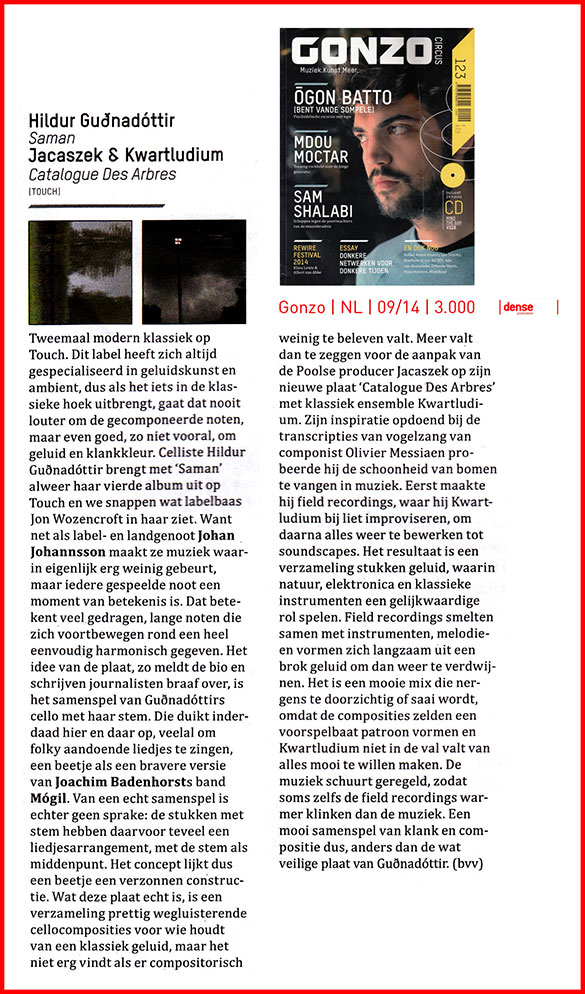
The Quietus (UK):
The vast majority of releases covered above are self-released, perhaps confirming the suspicion that the more outré oeuvres are not as sustainable by the now old school model of independent labels and publishers as they once were. Two grand examples to the contrary are Austria’s Editions Mego and UK’s Touch who both consistently and relentlessly continue to support and release fringe artists working in the liminal space between music and sound art. Touch’s latest two releases are prime examples of this.
Catalogue des Arbres, a collaboration between the Polish sound artist Michal Jacaszek and the Kwartludium quartet, sees Jacaszek’s field recordings of trees – their branches’ and leaves’ rustling responses to rain and wind – placed in concert with subtly processed recordings of Kwartludium’s violin, clarinet, percussion and piano. The resultant patina is a verdant ebb and flow of organically moving matter, fertile and furtive, whose considered diffusion brings its forest textures to the fore, spreading its moss, vines, tendrils and branches into your listening environment. [Russell Cuzner]
Musik an sich (Germany):
Michal Jacaszek ist ein angesehener polnischer Komponist und Musiker im elektronischen ebenso wie klassischem Bereich. Er hat bereits einige Preise für Filmmusiken erhalten.
Sein neues Album Catalouge des Apbres (Baumkatalog oder Katalog der Bäume) ist in Herangehensweise wie Umsetzung überaus ambitioniert.
Dem Titel entsprechend will der Künstler mit diesem Album einen Soundtrack der Bäume abliefern.. Dafür ist er zunächst in die Natur hinaus und hat Fieldrecordings von Bäumen unter den verschiedensten Wetterbedingungen aufgenommen. Diese hat er dann als Grundlage des Albums elektronisch verarbeitet um sie, da zitiere ich den Künstler, wie Drones unter seine Stücke zu legen. Das ist dem Künstler vollauf gelungen, wenn auch Drones nicht wirklich passt. Die Geräusche sind auf den 8 Stücken zwar allgegenwärtig, jedoch nicht so erdrückend wie Drones sondern tatsächlich als Soundteppich der Stücke anzusehen.
Darüber spielen viele verschiedene Künstler (siehe Liste im Kasten) eine dunkle, klassich oder auch Soundtrack anmutende Musik mit Klarinetten, Piano, Violine, Piano Perkussion und Stimmen. Diese wiederum wurden vom Künstler elektronisch verarbeitet und zusammen mit den Fieldrecordings zu den 8 dunklen Soundscapes zusammen gemicht.
Das Ergebnis ist schlicht faszinierend. Das dunkle “From The Seashell“ zum Beispiel wird von Holzklappern, Rauschen und Wind unterlegt, dunkle elektronische Sounds laufen darüber aus denen sich mal Violine, mal Klarinette herausarbeiten und zu einem zwischen Kammermusik und Postrock wankenden Sound aufbaut. Am Ende des Stücks laufen langsam gespielte einzelne Pianoklänge über den Sound und lassen das Stück ausklingen.
Ansonsten ist es schwierig, das hier zu hörende zu erklären. Es schwebt stets zwischen Klankunst, Klassik und dem erwähnten Postrock. Die eher zerbrechlich wirkenden, spärlichen akustischen Instrumente konterkarieren zumeist den dunklen elektronisch schwebenden Sound und die natürlichen Klangwelten, welche mitunter faszinierend sind. Zuteilen könnte dies die Musik sein, die Mark Hollies von Talk Talk am Ende seiner Karriere gern gemacht hätte.
ist ein überaus faszinierendes Abum geworden. Hier gibt es unglaublich viele Details zu hören und neue Sounds und musikalische Ideen (durchaus of auch auf den Jazz basierend) zu entdecken. Und bei aller Ambition und Experimentierwut ist es trotzdem ein hörbares, durchaus melodiöses Werk geworden und zefällt am Ende nicht nur in ambitionierten Klängen ohne Zusammenhalt.
Trotz seiner Tiefe und Opulenz (oder gerdae deswegen) auch ein Album für Einsteiger in diese etwas andersartigen Klangwelten. Ob man das nun Neoklassik, Moderne Klassik, Post was immer auch nennt ist eigentlich egal. Dieses Album ist ein Statemant für moderne Komposition und deren Umsetzung. 20/20 [Wolfgang Kabsch]
Rockaxis (Spain):
Hay muchos discos en los cuales la música deja de ser lo que es y se transforma en imágenes, muta en colores y en secuencias con vida. Por mencionar algunos claros ejemplos: “Delirium Cordia” de Fantômas, “Monoliths and Dimensions” de Sunn O))), “The Drift” de Scott Walker, y otros tantos más, en que la música se transforma en “metamúsica”, es decir, en aquello que va más allá de ella misma, aunque suene imposible e incluso paradójico, ya que probablemente más allá de la música no exista nada.
Este es otro caso de un disco de tales características, y está creado por el músico polaco Jacaszek, quien cuenta con ocho discos previos, todos enmarcados en la órbita de lo electroacústico ambiental a través de la utilización de técnicas computacionales, pero adornado con elementos doctos, como piano, violín, percusiones y clarinete, a cargo del cuarteto Kwartludium, y que han sido grabados y luego procesados a través de las máquinas de Jacaszek, e intentando hacer un paralelo, se posiciona al costado de otros artistas como Fennesz o William Basinski.
En este caso, el paisaje es desolador o lóbrego: Se percibe el sonido de las gotas de una llave cayendo entre la oscuridad, de la lluvia y del viento, el sonido de la devastación, del fuego consumiendo los últimos restos de leña seca. La humedad es la reinante por varias secciones de las ocho creaciones que componen el disco, las que llevadas al lugar común, serían la banda sonora de películas como “El Caballo de Turín” (2011) de Bela Tarr, o de “El Viento” (1928) de Victor Sjostrom, películas que cumplen con un riguroso blanco y negro.
El mismo autor ha citado como inspiración a Oliver Messiaen y sus trabajos en que utilizaba los cantos de los pájaros, transcribiendo dichos sonidos y llevándolos a la orquestación, al piano la mayoría de las veces, como en las obras “Réveil des Oiseaux” (1953) o “Catalogue d’Oiseaux” (1958) pero en este caso intentó musicalizar el sonido de otros fenómenos naturales, como la reflexión mística de los árboles, de sus “amados árboles”, como indica el mismo Jacaszek, de los cuales emana ese secreto tan inmenso y hermético, al cual es imposible acceder.
Por muchos momentos, la percepción de la oscura atmósfera es más cinematográfica, sintiéndose, por ejemplo, el soplido susurrante y misterioso de un clarinete, que nos lleva a la apreciación de una tenue luz, el disparo de una linterna en soliloquio contra el sombrío bosque, y que se disloca entre el follaje de los árboles, perdiendo su forma entre lo que no podemos percibir, tal ocurre por ejemplo en “A Book of Lake” o en “Circling”.
En otras composiciones, como en “Garden”, se siente una atmósfera abstracta, siempre nocturna, pero dotada de una lentitud soberbia, sobre todo por la ejecución de similares notas entre las cuales existe bastante espacio con sonidos que recorren en un segundo plano cada una de las anteriores: algo se quema, algo desaparece lentamente. Y también hay creaciones que se acercan a una especie de drone pero de características orgánicas, como en “Kingdom”.
Un disco ambiental, hosco, invernal y contemplativo, de impronta muy decadente y opresiva, como si se tratara de tiempos de crisis, o como si se intentara elogiar a la noche, tal como los nocturnos de la música docta, pero esta vez acercándose a ella a través de sus propios lamentos, de su propio hablar, de su propio respirar, uno parsimonioso y en extremo misterioso. Un disco que no solo se debe escuchar sino que debe ser experimentado o vivenciado. [Carlos Navarro Acosta]
Revue et Corrigé (France):
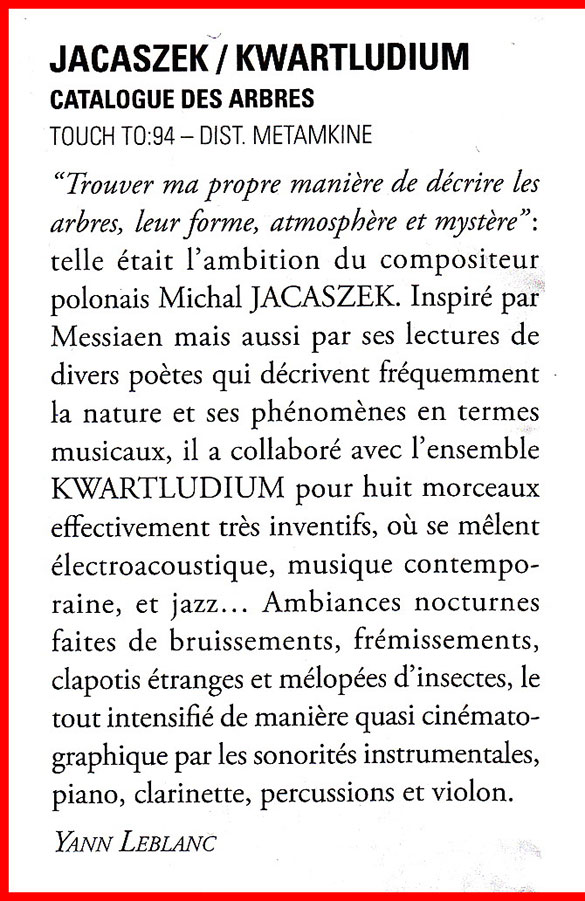
MI (Poland):
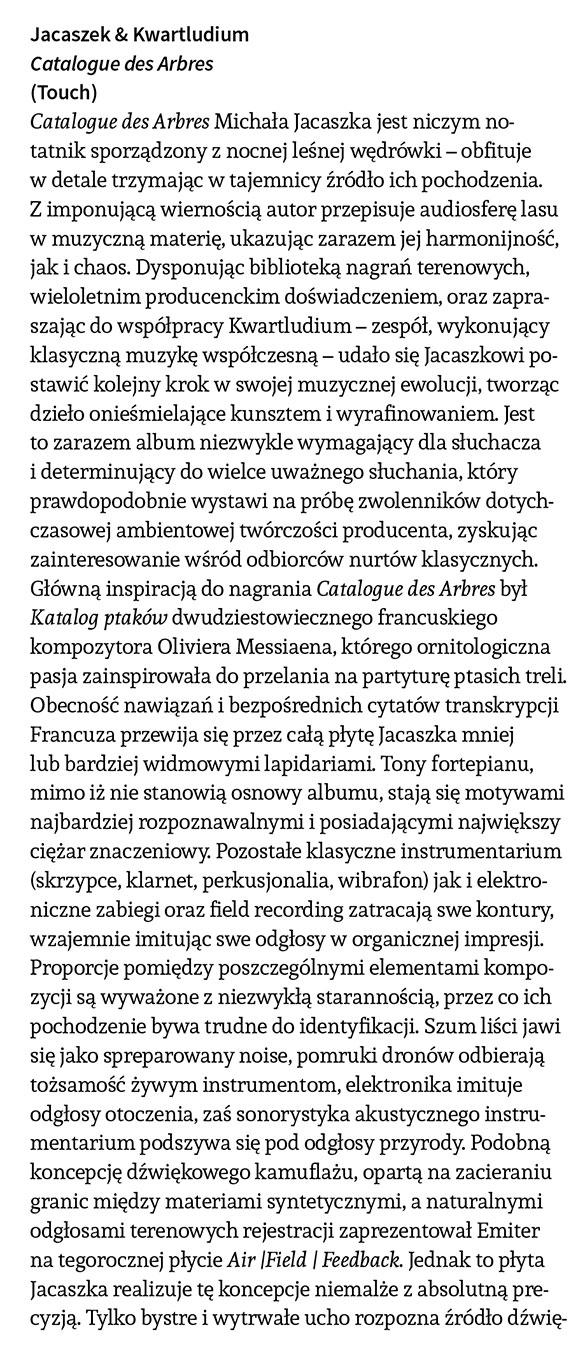
Newsweek (Poland):
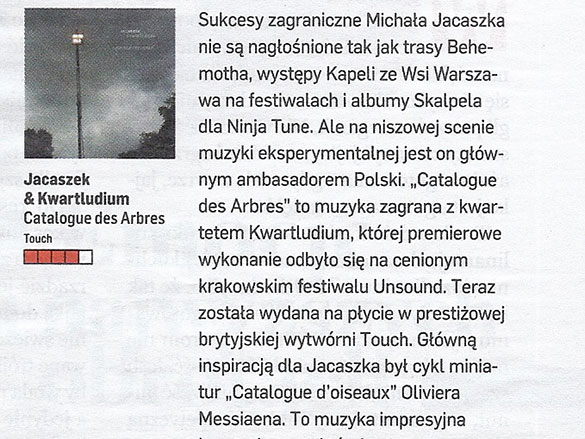
Polityka (Poland):
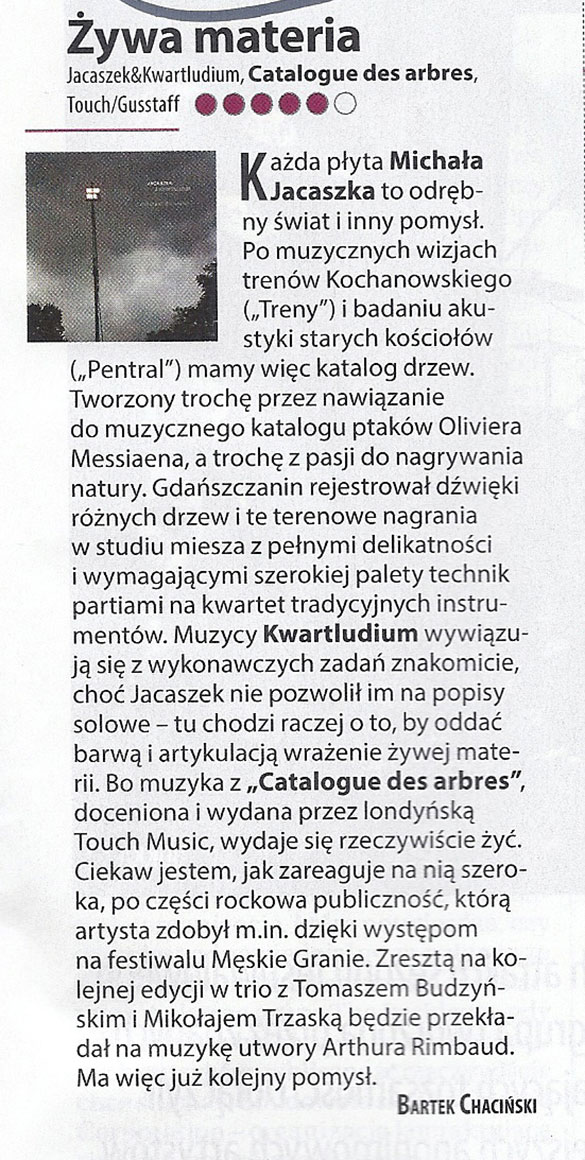
Blow Up (Italy):
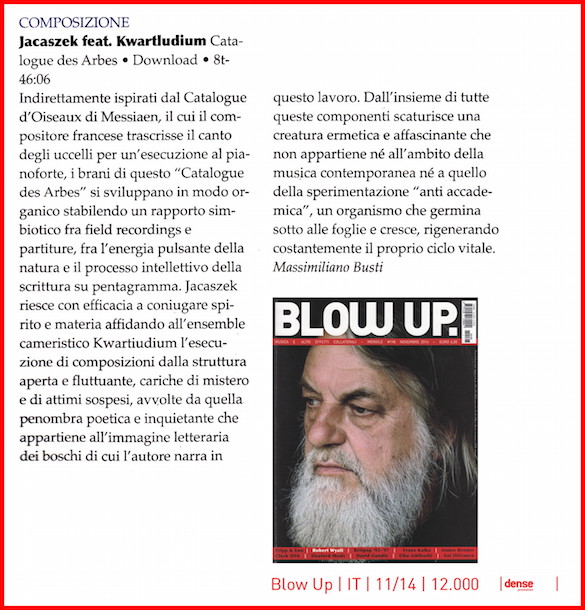
Ondarock (Italy):
Dopo una manciata di lavori introspettivi ai limiti dell’isolazionismo – “Treny” (Miasmah, 2008) e “Pentral” (Gustaff, 2009) – la musica del compositore polacco ha definitivamente lasciato i stretti limiti della dark ambient per espandersi in territori inesplorati con il meraviglioso “Glimmer” (Gustaff, 2011), un capolavoro di sincretismo tra musica classica, elettroacustica, ambient e jazz di scuola ECM.
Il recente “Catalogue Des Arbres” è una collaborazione tra Jacaszek e i connazionali Kwartludium, un quartetto di sperimentatori – violino, clarinetto, percussioni e pianoforte – che ha già pubblicato un album insieme a Robin Rimbaud, alias Scanner.
I timbri del quartetto acustico accentuano l’attitudine cameristica del nuovo corso di Jacaszek, che da parte sua enfatizza le dinamiche degli strumenti immergendole in una produzione che ne esalta i dettagli.
Dopo tre incantevoli passeggiate in boschi imperscrutabili – “Sigh (Les Peupliers)”, “Green Hour”, “A Book Of Lake” – il vuoto caratteristico dei precedenti lavori di Jacaszek si fa spazio con tutta la sua forza sulla lenta e scura “Garden (Les Sureaux)”, dove i timbri del clarinetto basso e del violino poggiano su un tappeto di detriti che crea la portante per un drone incantevole. Decisamente più sinistra l’atmosfera sulla seguente “From A Seashell”, dove i i crepitii e l’eco di suoni lontani enfatizzano l’attesa per qualcosa di oscuro e inaspettato. [Roberto Mandolini]
Jazz ‘n More (Germany):
